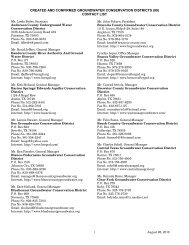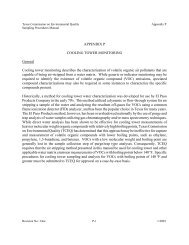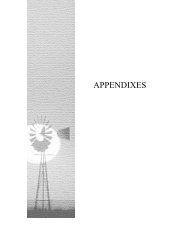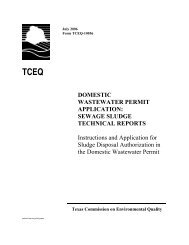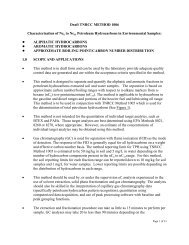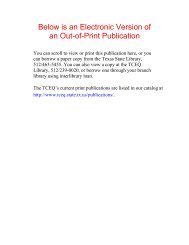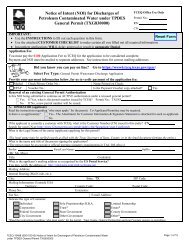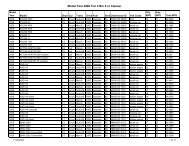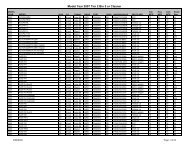Vinyl Chloride - Texas Commission on Environmental Quality
Vinyl Chloride - Texas Commission on Environmental Quality
Vinyl Chloride - Texas Commission on Environmental Quality
Create successful ePaper yourself
Turn your PDF publications into a flip-book with our unique Google optimized e-Paper software.
<str<strong>on</strong>g>Vinyl</str<strong>on</strong>g> chloride<br />
Page 18<br />
4.2.2 MOA Analysis<br />
VC carcinogenicity is thought to occur by a genotoxic mechanism as discussed previously in Secti<strong>on</strong><br />
4.1.2. VC is metabolized to a reactive metabolite (CEO) which then binds to DNA forming DNA adducts<br />
that, if not repaired, can lead to mutati<strong>on</strong>s and tumor formati<strong>on</strong> (USEPA 2000). Because carcinogenicity<br />
is thought to occur by a mutagenic MOA, and other more specific biologically-based models are not<br />
available, it is appropriate to use a linear (n<strong>on</strong>-threshold) approach to develop the chr<strong>on</strong>ic ESLlinear(c).<br />
4.2.3 Key Studies<br />
4.2.3.1 Human Epidemiologic Studies<br />
Human epidemiology studies dem<strong>on</strong>strate a clear associati<strong>on</strong> between VC exposure and liver cancer (i.e.,<br />
angiosarcoma and hepatocellular carcinoma) (see USEPA 2000 and ATSDR 2006 for complete reviews).<br />
Quantitative exposure informati<strong>on</strong> is <strong>on</strong>ly available for a few studies and is associated with a high level of<br />
uncertainty. Due to uncertainties associated with human exposure informati<strong>on</strong>, the TD adopted the risk<br />
estimate derived by USEPA (2000) using animal data which was subsequently used to develop the<br />
chr<strong>on</strong>ic ESLlinear(c). Cancer potency estimates derived from human studies are presented in Secti<strong>on</strong> 4.2.4.1 for<br />
comparis<strong>on</strong>.<br />
4.2.3.2 Animal Studies<br />
VC is carcinogenic by the oral and inhalati<strong>on</strong> routes of exposure in multiple animal species including rats,<br />
mice, and hamsters with the target organ being the same as in humans (the liver). Malt<strong>on</strong>i et al. (1981,<br />
1984) c<strong>on</strong>ducted the most comprehensive set of experiments in animals. Malt<strong>on</strong>i et al. (1981, 1984)<br />
evaluated the carcinogenicity of VC in Sprague-Dawley and Wistar rats, Swiss mice, and Golden<br />
hamsters. In an initial series of experiments, male and female Sprague-Dawley rats were exposed by<br />
inhalati<strong>on</strong> to 15 different doses of VC (0, 1, 5, 10, 25, 50, 100, 150, 200, 250, 500, 2500, 6000, 10,000,<br />
and 30,000 ppm) for 4 h/day, 5 days/week, for 52 weeks. Other experiments were performed over 5-, 17-,<br />
and 25-week periods.<br />
Experiments were also performed <strong>on</strong> pregnant Sprague-Dawley rats and embryos. The study examined<br />
effects between strains of rats (Sprague-Dawley versus Wistar) and different species (rats, mice, and<br />
hamsters) as well. Animals were kept alive until sp<strong>on</strong>taneous death. Full autopsy was performed <strong>on</strong> each<br />
animal and all parts of the body were examined.<br />
In Sprague Dawley rats, statistically significant increases were reported in the incidence of liver<br />
angiosarcoma, mammary gland carcinomas, Zymbal gland carcinomas, nephroblastoma, neuroblastoma,<br />
and forestomach tumors. The incidence of liver angiosarcoma was comparable between rat strains at<br />
doses up to 10,000 ppm. The incidence of several other tumor types were comparable between rat strains.<br />
In Swiss mice, liver angiosarcoma was reported in greater proporti<strong>on</strong>s at lower-dose levels after 30-week<br />
exposures than in Sprague-Dawley rats exposed for 52 weeks; however, the incidences were comparable<br />
at higher doses. The incidence of liver angiosarcoma in male hamsters was much less after a 30-week<br />
exposure than in male rats or male mice. Mammary gland tumors were reported in <strong>on</strong>ly rats and mice;<br />
Zymbal gland tumors, neuroblastomas, and nephroblastomas were reported in <strong>on</strong>ly rats; lung tumors were<br />
found in <strong>on</strong>ly mice; and melanomas, acoustical duct epithelial tumors, and leukemias were reported in<br />
<strong>on</strong>ly hamsters.<br />
Other animal studies have supported the carcinogenicity of VC (e.g., Bi et al. 1985, Drew et al. 1983,<br />
Holmberg et al. 1976, H<strong>on</strong>g et al. 1981, and Lee et al. 1977 and 1978). However, the Malt<strong>on</strong>i et al. (1981,



